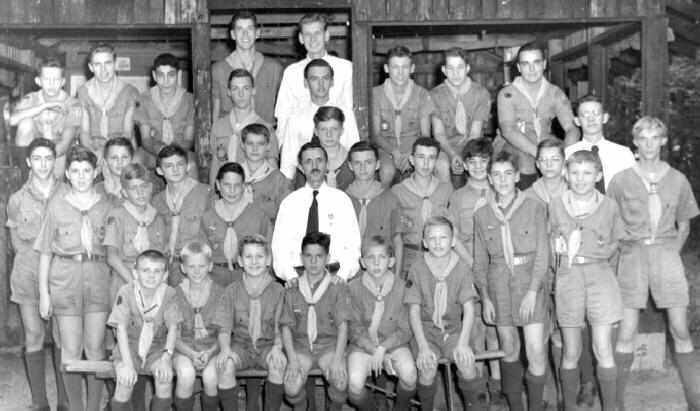
United States Boy Scout Camps: Chronology

Figure 1.--Here we see a group of American Scouts at camp in 1949. They all wear the short pants uniform which would have been a camp requirement. At the time, American Scouts did not commonly wrear wear the short pants uniform until the 1970s. Note the short hair cuts the boys wear. This dates the photograph to the 1940s-50s.
|
|
Anerican Scouts began camping from the earliest days of Scouting. In fact there was Scouting by predecessor groups even before the Boy Scouts of America (BSA) were fonded (1909). One of the main reasons for Scouting was to organize camoin experiences. A vast treasure of photographs exist from these camps. They illustrae activities and the uniforms worn at these camps over time. The image here shows American Scouts at camp in 1949. On the previous page we seea group from about 1960. The letters from the boys are another fascinating source of information from the camps over time. They are alwatys facinating to read. One HBC reader describes his letters home in 1972. They are an amusing read. One tells about their activities at camp, including cave exploring ("we saw bats and everything imaginable"), hiking ("I have 9 blisters"), and "scinnydipen", and end with "Hurry with the money. PLEASE." The other one tell about hiking "15 miles to the highest waterfall west of the Appellachens" and ends with "I spent 4 dollars on something you will see when I get home. I need 6 more dollars. P.S. Send Fast."
The 1910s
Anerican Scouts began camping from the earliest days of Scouting. In fact there was Scouting by predecessor groups even before the Boy Scouts of America (BSA) were fonded (1909). One of the main reasons for Scouting was to organize camoin experiences. Scouting groups did not have many actual camps they owned inthe 1910s. Thus the camping was done in parks or other public land and private lands. There are little or no facilities for the boys. One noticeable feature of Scout camping is that the camps almost always had the boys wear the short pants uniform rather than the knickers uniform that the boys mostly wore when not at camp. Actually a knickers uniform was a raity as Scouting spread around the world. In other countries there was usually a short pnts uniform both for summer camp as well as other activities during the year.
The 1920s
The decae following World War I meant that there was a lot of war surplus equipment available such as tents that could be used a Boy Scout camps.
Scouting was well estanlished in America by the 1930s. It was seen as a wholesome and patriotic activity. Many boys wanted to participate. The Depression may have prevented some paricipation, but Scouting was a miffle-class movement and was not very ecxpensive to participate, so oarticipation was not as avversely affected as one might think. Scout camps were increasingly common and more boys were attending the summer camos. We see considerable development of Boy Scout camps during the 1930s, despite the Depression. Scout Councils were buying camp sites. The most important feature that was needed was a lake-side location where water activities like swiming and boating could be located. We see construction of permanent facilities, but boys still commonly used tents in many of these new camps. Most American Scouts wore the knickers uniform in the 1930s, but while at camp mistly wore a short pants uniform.
The 1940s
The 1940s were dominated by World war II. America as a result of the Japanese attack on Pearl Harbor was propelled into World War II (December 1941). Scouts participated in a range of activities supporting the War effort, incliding scrap drives and bond sales. We are not sure at this time how the War effort affected camp attendance. The BSA made major changes in Cub and scout uniforms, phasing out the knicker uniforms. Here we see a group at camp after the War in 1949(figure 1). Notice what looks like some kind of meeing hall for evening activities. Many of the buildings in the camps were done with a rustic look.
The 1950s
The 1960s
Boy Scout camos were well established when a sibstantial phyicl plant nd facilities by the 1960s. Not only were there many camps owned by he various Scout Councils, but there wee a range of facilties that had been built for the boys. Most camps had cabins so the bots no longer slept in camps un;ess on outings. The image on the previou page shows American Scouts at camp about 1960.
The 1970s
The letters from the boys are another fascinating source of information from the camps over time. They are alwatys facinating to read. One HBC reader describes his letters home in 1972. They are an amusing read. One tells about their activities at camp, including cave exploring ("we saw bats and everything imaginable"), hiking ("I have 9 blisters"), and "scinnydipen", and end with "Hurry with the money. PLEASE." The other one tell about hiking "15 miles to the highest waterfall west of the Appellachens" and ends with "I spent 4 dollars on something you will see when I get home. I need 6 more dollars. P.S. Send Fast."
HBU

Navigate the Historic Boys' Uniform Chronology Pages:
[Return to the Main chronologies page]
[The 1900s]
[The 1910s]
[The 1920s]
[The 1930s]
[The 1940s]
[The 1950s]
[The 1960s]
[The 1970s]
[The 1980s]
[The 1990s]
[The 2000s]
Navigate the Historic Boys' Uniform Web Site:
[Activities]
[Biographies]
[Chronologies]
[Countries]
[Essays]
[Garments]
[Organizations]
[Religion]
[Other]
[Introduction]
[Bibliographies]
[Contributions]
[FAQs]
[Questions]
[Unknown images]
[Boys' Uniform Home]
Navigate the Historic Boys' Uniform Web organizatiion pages:
[Return to the Main U.S. Scout camp page]
[Return to the National Scout page]
[Boys' Brigade]
[Camp Fire]
[Hitler Youth]
[National]
[Pioneers]
[Royal Rangers]
[Scout]
Created: 7:40 PM 8/13/2004
Last updated: 4:09 AM 6/17/2015



